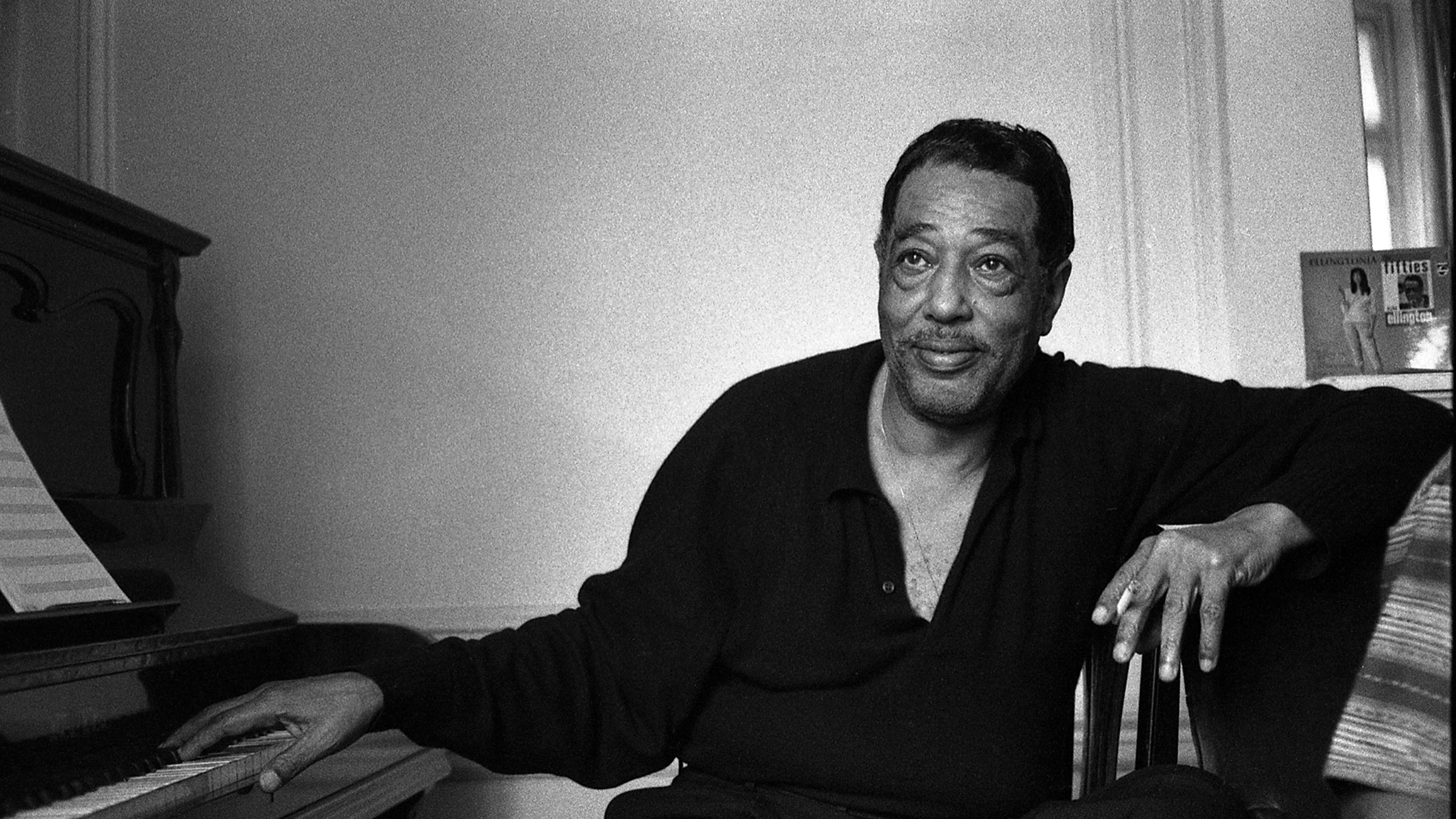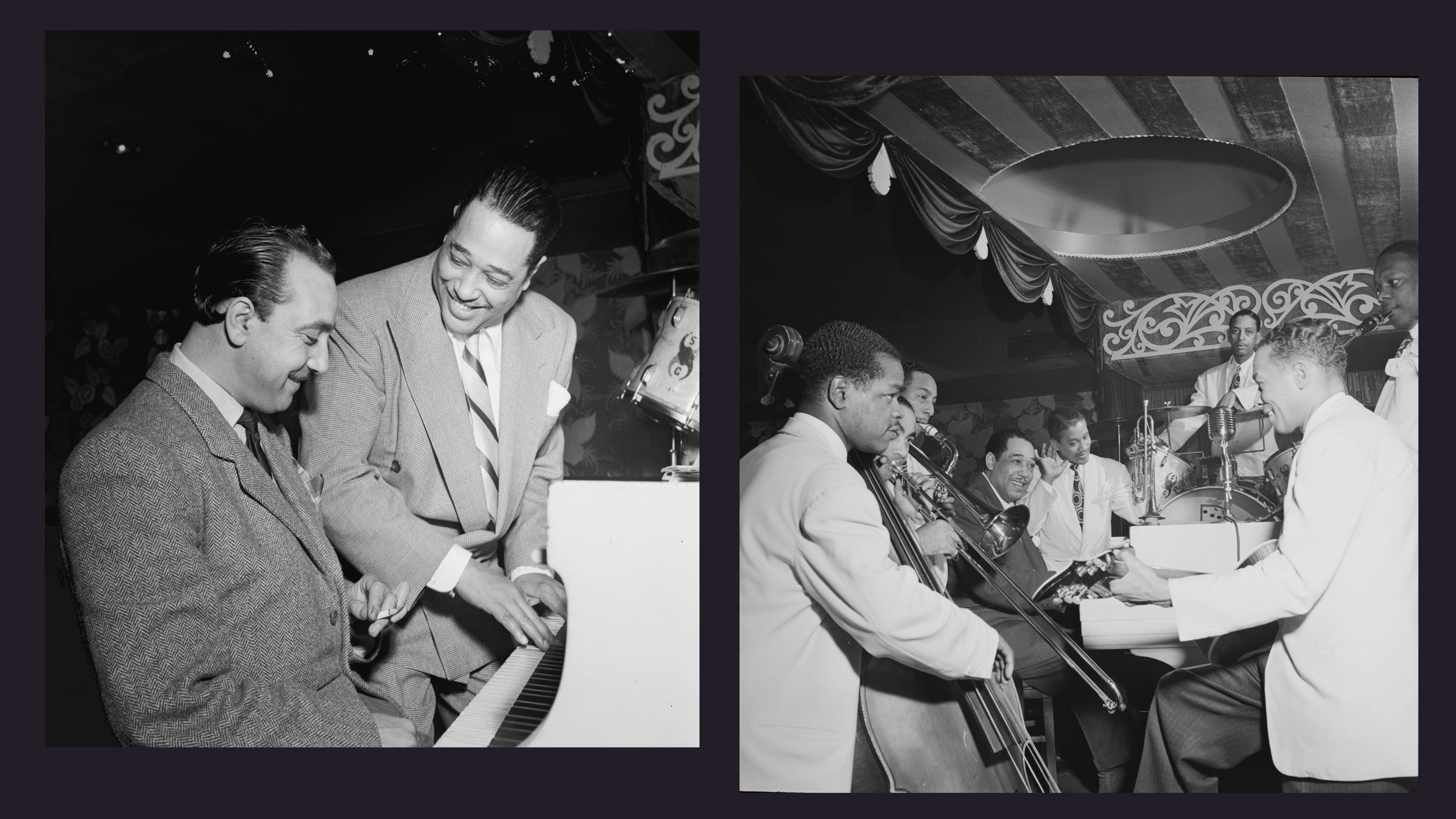Beyond Category
Edward Kennedy “Duke” Ellington
by John Edward Hasse, Ph.D, Grammy-nominated author, biographer, and record producer
Photo © Herman Leonard Photography, LLC.
No one led a band like Duke Ellington. No one led a life like Duke Ellington. And no one wrote music like Duke Ellington. He was one of a kind, beyond category.
Widely remembered as a pianist, Duke was much more. In my judgment, he was America’s greatest all-around musician: composer, orchestrator-arranger, conductor-bandleader, soloist, accompanist, and musical thinker. He was the supreme creator of music for that essential American institution: the jazz orchestra or big band.
Ellington’s band and his composing made a profound yin-yang: he couldn’t have one without the other. He composed the vast majority of the band’s repertoire. He wrote only for his band. And the band played mostly Ellington’s music—composed and/or arranged by him.
He hated being pigeonholed as strictly a jazz musician. Over his astonishingly productive fifty-year career leading the Duke Ellington Orchestra, he composed songs, short instrumentals, multi-movement suites, scores for ballets and motion pictures, and Broadway-bound musicals.
He was mostly known as a miniaturist for his three-minute evergreens such as Mood Indigo, Sophisticated Lady, and In a Sentimental Mood. But his lesser-known, large-scale works provided him with canvasses to tell bigger stories, inspired by, among other topics, African American history, his overseas travels, and his reverence for God. He expressed a drive to be the best, to create a unique sound and to break out of musical categories, a deep respect for his heritage—and, increasingly, a faith in the Divine.
He managed to create an orchestra that sounded unlike any other. He selected players for their distinctive voices and learned to downplay their weaknesses, emphasize their strengths, and enhance their best qualities. He led a collective that brought the utmost out in each person.
Like a master chef, he alchemized his ingredients—the signature styles of his musicians—into a whole that was greater than the sum of its parts. He personalized his music to an unprecedented degree, writing parts not for the instrument, but for the specific musician playing the instrument—saxophonist Johnny Hodges or trumpeter Clark Terry. Duke and his players rank as some of the greatest musical individualists of the twentieth century.
Duke Ellington left an enormous legacy: 10,000 recordings and 100,000 pages of unpublished scores and parts. I know the latter number because I led the Smithsonian’s acquisition of this national treasure to make it available and preserve it for posterity. The collection’s proud home is the National Museum of American History, in Washington, DC.
Born Edward Kennedy Ellington in Washington, DC, on April 29, 1899, he drew the nickname “Duke” from a childhood friend for his fashionable clothing and exquisite manners. He moved to New York City in 1923 and died there on May 24, 1974.
He overcame one racial barrier after another to perform in nightclubs and hotels previously barred to Black people. He became a cultural hero to millions. The Black photographer Gordon Parks wrote, “Ellington had always been my hero. Unlike Black Hollywood stereotypes he never grinned, he smiled; he never shuffled, he strode. It was always ‘Good evening, ladies and gentlemen’ never ‘How y’all doing?’ At his performances we young Blacks sat high in our seats, wanting the whites to see us; to know that this handsome, elegant, sharply dressed man playing that beautiful, sophisticated music, was one of us.”
Duke traveled to perform in 65 countries. He sometimes toured for the U.S. State Department, as an unofficial ambassador of goodwill and great music. In some countries, he absorbed musical impressions that found their way into his works, for example, in The Far East Suite.
Duke’s personality was as distinctive as his music was. He was highly individualistic—in his use of language, in his clothing, in the music he wrote, and in his overall style.
As a hobby, he dabbled in painting. His favorite color was blue, whose varied hues showed up in several of his compositions: Mood Indigo, Azure, Blue Serge, Transblucency, On a Turquoise Cloud, and more.
Duke himself once said, “I hear a note by one of the fellows in the band and it’s one color. I hear the same note played by someone else and it’s a different color. When I hear sustained musical tones, I see just about the same color as you do, but I see them in textures. If [baritone saxophonist] Harry Carney is playing, D is dark blue burlap. If [alto saxophonist] Johnny Hodges is playing, G becomes light blue satin.”
He was a restless innovator, a ceaseless problem solver who kept evolving, remaining open to new sounds, influences, and ideas. In this respect, he was like Pablo Picasso, Frank Lloyd Wright, or Miles Davis. As a result of his artistic growth, Duke’s work of the 1970s sounded different in many ways from that of fifty years earlier—yet it was all unmistakably Ellingtonian.
By the time he was in his 60s, the honors were rolling in, including Grammy Awards, 17 honorary doctorates, his visage on postage stamps in Africa, and France’s highest award: the Legion of Honor. Yet one award eluded him when the Pulitzer Prize committee rejected Duke for a special citation. With typical irony, he declared “Fate is being kind to me. It doesn’t want me to be famous too young.” He was 66 at the time. Behind the public facade, he was deeply hurt and angered. “What we do, what other black musicians do,” he said, “has always been like the kind of man you wouldn’t want your daughter to associate with.”
In 1969, President Richard M. Nixon awarded Ellington the Presidential Medal of Freedom, the nation’s highest civilian award, at a star-studded ceremony at the White House.
That night might have been the capstone of his career—and especially sweet, since his father had occasionally served as a butler at the Presidential mansion, entering through the service entrance. Ellington proudly walked through the front door. The 12-block journey from his birthplace to the White House took the maestro 70 years and 10 million miles of travel.


